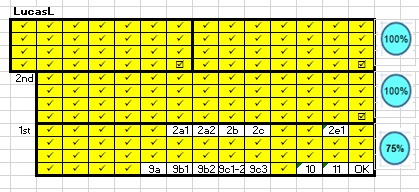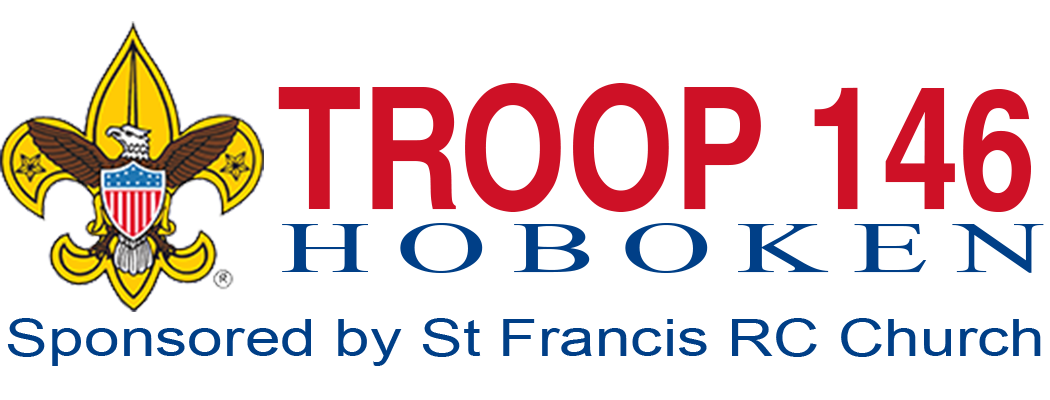LucasL
Revised 05/29/25

Scout To-Do
Scout Done
Complete 03/02/20
Arrow of Light
Tenderfoot To-Do
Tenderfoot Done
Complete 09/28/21
Second Class To-Do
Second Class Done
Complete 08/02/22
First Class To-Do
4b. Demonstrate how to use a handheld GPS unit, GPS app on a smartphone, or other electronic navigation system. Use GPS to find your current location, a destination of your choice, and the route you will take to get there. Follow that route to arrive at your destination.
9a. Visit and discuss with a selected individual approved by your leader (for example, an elected official, judge, attorney, civil servant, principal, or teacher) the constitutional rights and obligations of a U.S. citizen.
9b. Investigate an environmental issue affecting your community. Share what you learned about that issue with your patrol or troop. Tell what, if anything, could be done by you or your community to address the concern.
9c. On a Scouting or family outing, take note of the trash and garbage you produce. Before your next similar outing, decide how you can reduce, recycle, or repurpose what you take on that outing, and then put those plans into action. Compare your results.
10. Tell someone who is eligible to join Boy Scouts, or an inactive Boy Scout, about your Scouting activities. Invite him to an outing, activity, service project, or meeting. Tell him how to join, or encourage the inactive Boy Scout to become active. Share your efforts with your Scoutmaster or other adult leader.
11. Demonstrate Scout spirit by living the Scout Oath and Scout Law. Tell how you have done your duty to God and how you have lived four different points of the Scout Law (different from those points used for previous ranks) in your everyday life.
• ________________________
• ________________________
• ________________________
• ________________________
[Tenderfoot covered: Loyal, Helpful, Kind, Brave]
[2nd Class covered: Trustworthy, Brave, Clean, Reverent]
12. While working toward the First Class rank, and after completing Second Class requirement 11, participate in a Scoutmaster conference.
13. Successfully complete your board of review for the First Class rank. Successfully complete your board of review for the First Class rank.
First Class Done
1a1. Since joining Boy Scouts, participate in 10 separate troop/patrol activities.
1a2. Since joining Boy Scouts, participate in 6 separate outdoor troop/patrol activities.
1a3. Since joining Boy Scouts, participate in 3 overnight camping activities. These activities do not include troop or patrol meetings. On campouts, spend the night in a tent that you pitch or other structure that you help erect, such as a lean-to, snow cave, or tepee.
1b1. Explain each of the principles of Tread Lightly!
1b2. Tell how you practiced “Tread Lightly” principles on a campout or outing. This outing must be different from the ones used for Tenderfoot requirement 1c and Second Class requirement 1b.
2a1. Help plan a menu for one of the above campouts that includes at least one breakfast, one lunch, and one dinner, and that requires cooking at least two of the meals.
2a2. Tell how the menu includes the foods from MyPlate or the current USDA nutritional model and how it meets nutritional needs for the planned activity or campout.
2b. Using the menu planned in First Class requirement 2a, make a list showing a budget and the food amounts needed to feed three or more boys. Secure the ingredients.
2c. Show which pans, utensils, and other gear will be needed to cook and serve these meals.
2d1. Demonstrate the procedures to follow in the safe handling and storage of fresh meats, dairy products, eggs, vegetables, and other perishable food products.
2d2. Show how to properly dispose of camp garbage, cans, plastic containers, and other rubbish.
2e1. On one campout, serve as cook. Supervise your assistant(s) in using a stove or building a cooking fire. Prepare the breakfast, lunch, and dinner planned in First Class requirement 2a.
2e2. [Serve as cook and] Supervise the cleanup.
3a. Discuss when you should and should not use lashings.
3b. Demonstrate tying the timber hitch and clove hitch.
3c. Demonstrate tying the square, shear, and diagonal lashings by joining two or more poles or staves together.
3d. Use lashings to make a useful camp gadget or structure.
4a1. Using a map and compass, complete an orienteering course that covers at least one mile.
4a2. Measure the height and/or width of designated items (tree, tower, canyon, ditch, etc.).
5a. Identify or show evidence of at least 10 kinds of native plants found in your local area or campsite location. You may show evidence by identifying fallen leaves or fallen fruit that you find in the field, or as part of a collection you have made, or by photographs you have taken.
5b. Identify two ways to obtain a weather forecast for an upcoming activity. Explain why weather forecasts are important when planning for an event.
5c1. Describe at least three natural indicators of impending hazardous weather.
5c2. Describe the potential dangerous events that might result from [hazardous] weather conditions, and the appropriate actions to take.
5d. Describe extreme weather conditions you might encounter in the outdoors in your local geographic area. Discuss how you would determine ahead of time the potential risk of these types of weather dangers, alternative planning considerations to avoid such risks, and how you would prepare for and respond to those weather conditions.
6a. Successfully complete the BSA swimmer test.
6b. Tell what precautions must be taken for a safe trip afloat.
6c. Identify the basic parts of a canoe, kayak, or other boat. Identify the parts of a paddle or an oar.
6d. Describe proper body positioning in a watercraft, depending on the type and size of the vessel. Explain the importance of proper body position in the boat.
6e. With a helper and a practice victim, show a line rescue both as tender and as rescuer. (The practice victim should be approximately 30 feet from shore in deep water.)
7a. Demonstrate bandages for a sprained ankle and for injuries on the head, the upper arm, and the collarbone.
7b1. By yourself and with a partner, show how to transport a person from a smoke-filled room.
7b2. By yourself and with a partner, show how to transport for at least 25 yards a person with a sprained ankle.
7c1. Tell the five most common signals of a heart attack.
7c2. Explain the steps (procedures) in cardiopulmonary resuscitation (CPR).
7d. Tell what utility services exist in your home or meeting place. Describe potential hazards associated with these utilities and tell how to respond in emergency situations.
7e. Develop an emergency action plan for your home that includes what to do in case of fire, storm, power outage, and water outage.
7f. Explain how to obtain potable water in an emergency.
8a. After completing Second Class requirement 7a, be physically active at least 30 minutes each day for five days a week for four weeks. Keep track of your activities.
8b. Share your challenges and successes in completing First Class requirement 8a. Set a goal for continuing to include physical activity as part of your daily life.
9d. Participate in three hours of service through one or more service projects approved by your Scoutmaster. The project(s) must not be the same service project(s) used for Tenderfoot requirement 7b and Second Class requirement 8e. Explain how your service to others relates to the Scout Law.
Star To-Do
1. Be “active” in your troop for at least 4 months as a First Class Scout.
2. As a First Class Scout, demonstrate Scout spirit by living the Scout Oath and Scout Law. Tell how you have done your duty to God and how you have lived the Scout Oath and Scout Law in your everyday life.
4. While a First Class Scout, participate in 6 hours of service through one or more service projects approved by your Scoutmaster.
5. While a First Class Scout, serve actively in your troop in a position of responsibility for 4 months.
6a. With your parent or guardian, complete the exercises in the pamphlet “How to Protect Your Children From Child Abuse: A Parent’s Guide”.
6b. View the Personal Safety Awareness videos (with your parent or guardian’s permission).
7. While a First Class Scout, participate in a Scoutmaster conference.
8. Successfully complete your board of review for the Star rank.
Star Done
3a. Earn 4 Eagle-required merit badges.
Personal Fitness
First Aid
Emergency Preparedness
Environmental Science
3b. Earn 2 “other” merit badges.
Moviemaking
Engineering
For Camping merit badge: 12 nights
Life To-Do
1. Be active in your troop for at least 6 months as a Star Scout.
2. As a Star Scout, demonstrate Scout spirit by living the Scout Oath and Scout Law. Tell how you have done your duty to God and how you have lived the Scout Law in your everyday life.
3a. Earn a total of 7 Eagle-required merit badges.
[need 1 more]
4. While a Star Scout, participate in 6 hours of service through one or more service projects approved by your Scoutmaster. At least 3 hours of this service must be conservation related.
5. While a Star Scout, serve actively in your troop for 6 months in a position of responsibility.
6. While a Star Scout, use the Teaching EDGE method to teach another Scout (preferably younger than you) the skills from 1 of 7 choices, so that he is prepared to pass those requirements to his Scoutmaster’s satisfaction.
7. While a Star Scout, participate in a Scoutmaster conference.
8. Successfully complete your board of review for the Life rank.
Life Done
3a. Earn a total of 7 Eagle-required merit badges.
Personal Fitness (from Star)
First Aid (from Star)
Emergency Preparedness (from Star)
Environmental Science (from Star)
Swimming
Lifesaving
3b. Earn a total of 4 “other” merit badges.
Moviemaking (from Star)
Engineering (from Star)
Weather
Game Design
Eagle To-Do
1. Be active in your troop for a period of at least six months as a Life Scout.
2. As a Life Scout, demonstrate Scout spirit by living the Scout Oath and Scout Law. Tell how you have done your duty to God, how you have lived the Scout Oath and Scout Law in your everyday life, and how your understanding of the Scout Oath and Scout Law will guide your life in the future. List on your Eagle Scout Rank Application the names of individuals who know you personally and would be willing to provide a recommendation on your behalf, including parents/guardians, religious (if not affiliated with an organized religion, then the parent or guardian provides this reference), educational, employer (if employed), and two other references.
3a. Earn a total of 14 Eagle-required merit badges.
[need 8 more]
4. While a Life Scout, serve actively in your troop for six months in a position of responsibility.
5. While a Life Scout, plan, develop, and give leadership to others in a service project helpful to any religious institution, any school, or your community. (The project must benefit an organization other than the Boy Scouts of America.) A project proposal must be approved by the organization benefiting from the effort, your Scoutmaster and unit committee, and the council or district before you start. You must use the Eagle Scout Service Project Workbook, BSA publication No. 512-927, in meeting this requirement.
6. While a Life Scout, participate in a Scoutmaster conference.
7. Successfully complete your board of review for the Eagle Scout rank.
Eagle Done
3a. Earn a total of 14 Eagle-required merit badges.
Personal Fitness (from Star/Life)
First Aid (from Star/Life)
Emergency Preparedness (from Star/Life)
Environmental Science (from Star/Life)
Swimming (from Star/Life)
Lifesaving (from Star/Life)
3b. Earn a total of 7 “other” merit badges.
Moviemaking (from Star/Life)
Engineering (from Star/Life)
Weather (from Star/Life)
Game Design (from Star/Life)
Archery
Leatherwork
Geology
Extra: Canoeing
Extra: Rowing
Extra: Wood Carving
Extra: Sculpture
Extra: Rifle Shooting
Extra: Shotgun Shooting

